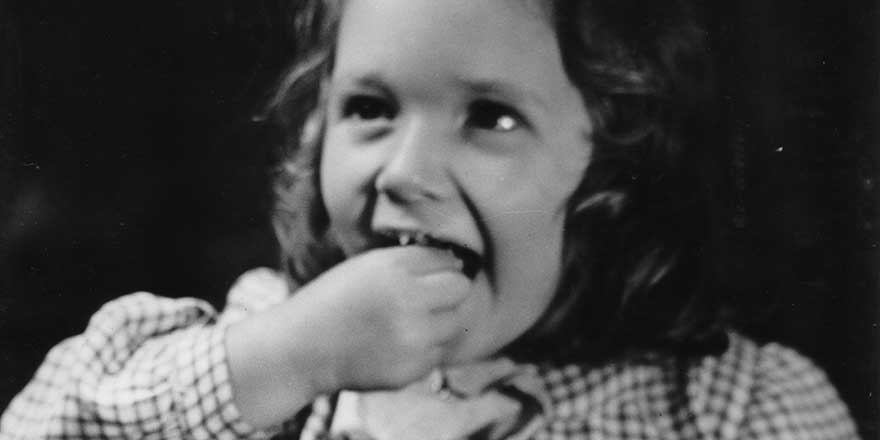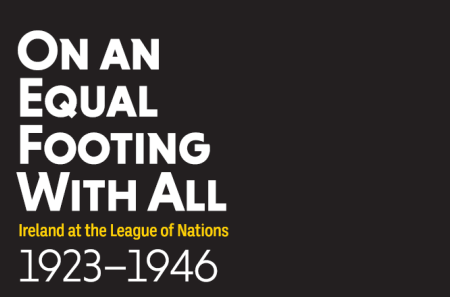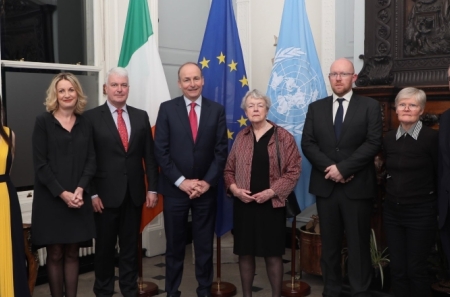
Documents on Irish Foreign Policy Vol. VIII (1945–1948) now free to access online
07 April 2020Documents on Irish Foreign Policy Vol. VIII (1945–1948), originally published in 2012, is now available online in open-access format. Originally scheduled for release on our forthcoming new website, we are releasing it ahead of schedule on our existing site. We hope it is of some interest in what are undoubtedly difficult times.
Introduction
Nazi gold, fugitive war criminals, the rebuilding of Europe, the threat of nuclear war and the growing dominance of Communism: these are among the central themes of the eighth volume of Documents on Irish Foreign Policy, the open-access version of which is now available online. Originally published in 2012, it covers the period from end of the Second World War in 1945 to the aftermath of Fianna Fáil's defeat in the 1948 general election. This unique edition of primary source material (drawn from the National Archives of Ireland and UCD Archives) explores the immediate post-war years during which Ireland was forced to grapple with the challenges presented by the aftermath of the Second World War, and the emergence of the Cold War.
The dedicated open-access DIFP website is being expanded and redesigned, and will be relaunched later in the year. But in the circumstances of the COVID-19 outbreak, we are making DIFP VIII free to access on our existing platform, ahead of the website relaunch. And to provide an overview of the period covered by the volume, here is an edited extract from our recently-published centenary history of Irish foreign policy by John Gibney, Michael Kennedy and Kate O'Malley, Ireland: A voice among the nations.
Explore DIFP Vol. VIII online here
From Ireland: A voice among the nations
The Second World War formally ended in Europe in May 1945. As the continent returned to peace, the Fianna Fáil government of Éamon de Valera began to adjust to the challenges of the post-war world. In September 1945 senior diplomats, and officials from other key departments, met in Dublin at the headquarters of the Department of External Affairs, at Iveagh House on St Stephen’s Green, for an unprecedented four days of discussions on the future direction of Irish foreign policy.
After the critical interlude of the ‘Emergency’, many crucial pre-war issues, such as Anglo–Irish relations, participation in international institutions and the maintenance of international sovereignty, resumed their places as the central concerns of Irish foreign policy. De Valera, as Taoiseach and Minister for External Affairs, stressed the need to redouble efforts to end the partition of Ireland and secure Ireland’s national identity in an increasingly Anglo-American dominated world. He accepted that the legacy of neutrality would make relations with Britain and the United States difficult in the short to medium term.
Ireland’s immediate post-war foreign policy was concerned not with these idealistic plans, however, but with specific technical and legal legacies of the war. This included explaining to the Allies that there were no significant German assets in Ireland, seeking compensation for bombing of Irish territory, dealing with German internees in Ireland and former Axis diplomats in Dublin, ensuring the removal of British minefields off the southeast coast, and addressing the position of Irish nationals who had fought in the Allied forces; especially those Defence Forces deserters who had joined the Allied armies. External Affairs did ask its overseas missions to stress that legislative action against these men was taken because they had deserted the Irish Defence Forces and not because they had fought with the Allies. Dublin would not do anything overt to alienate the victorious Allies, but this was a small attempt to demonstrate that as a sovereign state Ireland would not automatically accede to what appeared to be unilateral demands from the victors of the war.
A more pressing issue, which provoked considerable disagreement between the departments of External Affairs, Justice and Industry and Commerce, was the post-war immigration of displaced persons from Europe to Ireland. The three departments were aware of the need to guard against the arrival in Ireland of individuals sought by the Allies. But the Department of Justice remained opposed generally to opening up immigration to Ireland, particularly for Jews, the arrival of significant numbers of whom, it was argued, would stir up anti-Semitic feeling. In addition, the Minister for Industry and Commerce, Seán Lemass, was opposed in principle to allowing refugees into Ireland purely on humanitarian grounds. For Lemass, refugees had to have the specific skills and resources that Ireland needed for economic modernisation (a stance that dated from before the Second World War).
The more open views of the Department of External Affairs won the argument, at least in theory. De Valera himself favoured the admission of at least 10,000 refugees to Ireland, though no such numbers were actually admitted. Ireland did not adopt a welcoming attitude to refugees in the post-war years. Immigration of all kinds, but particularly that of displaced families without resources, continued to be viewed largely in terms of the alleged burden it placed on the taxpayer, and the associated risk of public resentment, rather than of wider humanitarian and other considerations.
Maintaining Anglo–Irish relations remained vital to independent Ireland. In July 1945 Britain's wartime coalition government led by Winston Churchill was replaced in the first post-war British election by a Labour government led by Clement Attlee. It was expected by External Affairs, without any solid evidence, to adopt a warmer attitude to Ireland than its predecessor. Although British resentment of Irish neutrality endured, the Anglo–Irish relationship was moving on because of economic and geopolitical necessity and the practicalities of the close connections between the two jurisdictions. The United Kingdom, faced with the massive challenges of post-war reconstruction at home and in Europe, needed Irish food and Irish labour. Ireland, equally, needed outlets for her produce and for her emigrants.
Attlee’s government was also expected by Dublin to display less commitment to Northern Ireland, and even to be well disposed towards ending partition by negotiation. Northern Ireland’s strategic wartime role in the Allied victory had, however, augmented Belfast’s standing in London and the new Attlee government, many of whom had served in Churchill’s wartime coalition, displayed no interest at all in moving to end partition or even to put pressure on the unionist administration in Belfast to take a more accommodating approach towards the Catholic minority population in Northern Ireland. Cross-border relations remained frozen. The differing paths taken by Dublin and Belfast during the Second World War ensured that the two Irish jurisdictions were, if anything, further apart in 1945 than had been the case in 1939. Northern Ireland did not receive a great deal of attention in Dublin in the immediate post-war years.
Dublin felt that one of the legacies of neutrality was that London and Washington purposely ignored Ireland’s post-war relief programme to Europe. Using food and materials stockpiled for domestic use during the war, Ireland made aid available to Europe through 1945 and into 1946. The initial focus was the Netherlands, Belgium, France, Germany and Italy, but aid was redirected to central Europe in 1946, and consignments of food and living materials were sent to Poland, Yugoslavia and Hungary.
External Affairs had a particular interest in post-war developments in Eastern European countries with significant Catholic populations, specifically Poland and Yugoslavia. The threat posed by the Soviet Union to these countries became a recurrent theme in Irish foreign policy after 1945. The commencement of the Cold War called a halt to plans to initiate formal diplomatic relations with the states of Eastern Europe for over a generation. Joseph Walshe, who moved from the role of secretary of the Department of External Affairs to became ambassador to the Holy See from 1946, and the vastly experienced Michael MacWhite in Rome were External Affairs’ most active commentators on the development of the Cold War in Europe. The Irish legations in Paris, Madrid and Lisbon, on the other hand, were often quiet places during the immediate post-war years.
The Irish diplomatic network did begin to expand, both inside and outside Europe, as peace returned. New offices were opened in Canberra (1946), Stockholm (1947), and Buenos Aires (1947). Ireland’s presence in Canberra was initially focussed on the Irish community in Australia and Ireland’s links with Australia as a dominion, but the mission provided Dublin with its first insight into post-war Asia. The chargé d’affaires in Buenos Aires had the short-term goal of ensuring wheat supplies for post-war Ireland, but was mainly concerned with the large Irish community in Argentina. The opening of this mission, along with that in Canberra, indicated a growing concern for the wider Irish diaspora. The legation in Stockholm gave Ireland its first formal diplomatic contacts with Scandinavia, and this along with the mission in Berne became extremely important in developing Dublin’s understanding of the outlook of fellow European neutrals.
Ireland remained a member of the League of Nations until its dissolution in April 1946. It was not a founding member of the new United Nations in 1945, having neither sought nor received an invitation to attend the San Francisco conference that established the organisation. On 2 August 1946, Éamon de Valera informed the UN’s first secretary-general, Trygve Lie, that Ireland was applying for membership and was prepared to accept the obligations contained in the UN Charter. But on 29 August the Soviet Union vetoed Ireland’s admission, citing the country’s wartime neutrality and its lack of diplomatic relations with Moscow (Ireland was one of a number of Western states whose admission was vetoed by the Soviets). There was an element of Cold War politics in the Soviet action, as Ireland was seen as a natural ally of the Western powers. In fact, all other members of the Security Council, including Poland, supported Ireland’s bid for UN membership. Irish hopes were repeatedly dashed over the next nine years by the Soviet stance. Lie’s successor as UN secretary-general, Dag Hammarskjöld, noted in 1954 that half the states of Europe, including Ireland, remained absent from the General Assembly.
An Anglo-French invitation to participate in the Conference on European Economic Co-operation (CEEC) in July 1947 gave a new impetus to Irish foreign policy. In 1946 Frederick Boland had replaced Joseph Walshe as secretary of the Department of External Affairs, and he guided Ireland through its first steps in multilateral economic and financial diplomacy via involvement in the United States’ move to reconstruct Europe’s devastated economies through the European Recovery Programme (the Marshall Plan). The international conferences and committees Boland attended from the summer of 1947 gave External Affairs a much greater insight into the challenges of European reconstruction and recovery, and especially the question of how to rebuild Germany as the engine of European growth. Boland began to establish informal alliances with the Swiss and the Swedes, knowing that de Valera’s preference was for Ireland to associate primarily with other European neutrals.
Though given a considerable degree of latitude, Boland, like Walshe, made sure to obtain de Valera’s consent on all major decisions. He also ensured de Valera’s attendance at the closing session of the CEEC in Paris. The conference was convened in order to draw up an inventory of European needs for recovery to present to the United States government, which was preparing to distribute extensive aid to post-war Europe under the Marshall Plan. The conference established the Organisation for European Economic Co-operation (OEEC), membership of which allowed Ireland to become involved once again in mainstream European multilateral relations.
Early Irish views on European unity did not go beyond advocating the primacy of the nation state in a ‘Europe of the states’. Sharing or pooling sovereignty, as the 1950 European Coal and Steel Community would later propose, was not then considered. De Valera remained sceptical of the concept of a customs union, although he had no difficulty with Ireland being party to discussions on its establishment. Post-war Ireland remained tied economically and financially to Britain. The impact of this on Ireland’s economy and national finances became clear in August 1947, when Sterling ceased to be convertible against the dollar and Ireland, as a member of the Sterling Area pool, was forced to negotiate with Britain to ensure that it was able to maintain a supply of dollars to buy American imports.
This economic crisis demonstrated that the Department of External Affairs and the Department of Finance had fundamentally different views of Ireland’s place in the international economic system. External Affairs looked to develop a specific Irish attitude towards the international monetary and financial system, whereas Finance maintained that Ireland’s international economic and financial position was best served by maintaining a close relationship with London. It was a difference of opinion that would recur as Ireland slowly shifted its foreign policy focus toward Europe and European integration. But this lay in the future: in February 1948 when, as the result of a general election defeat, de Valera and Fianna Fáil left office after sixteen years, the adjustment of Irish foreign policy to meet the challenges of the post-war world was far from complete.
Cover image: An unidentified but nonetheless delighted Italian girl eating from a packet of Irish sugar distributed as food aid in Italy in 1946. After the end of the Second World War, the Irish government followed the example of other neutral states such as Sweden and Switzerland and established humanitarian aid programmes to provide food, material and medical supplies across post-war Europe. Image reproduced by permission of the Director of the National Archives of Ireland.
Banner image on homepage: Aid distribution in post-war Berlin. The gender and age profiles of those pictured suggest that many younger men were unavailable to take part, perhaps having been killed or captured during the war. Image reproduced by permission of the Director of the National Archives of Ireland.



